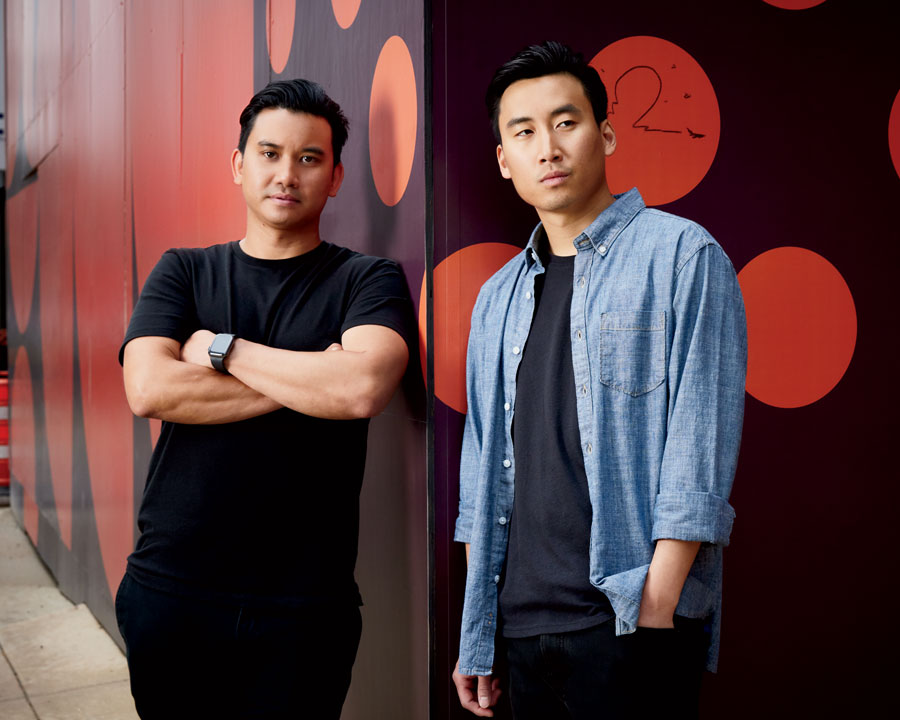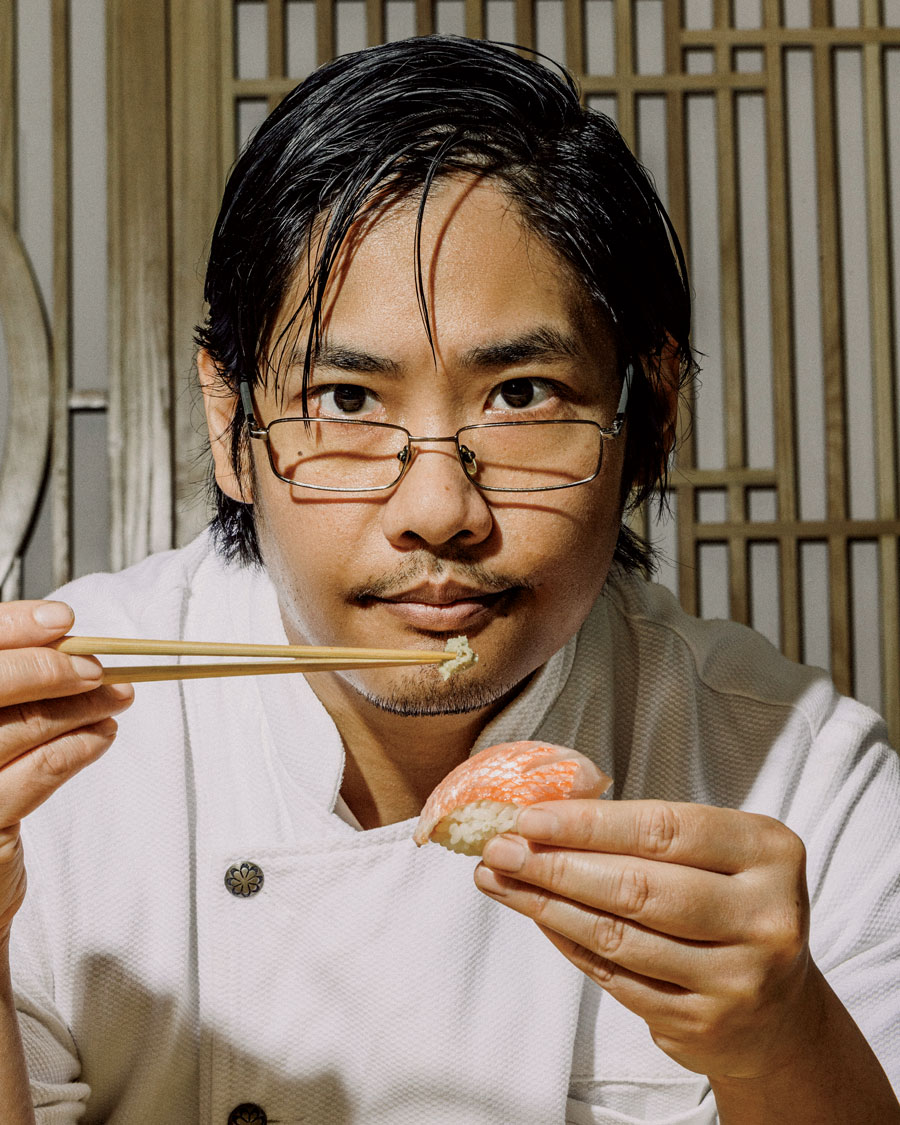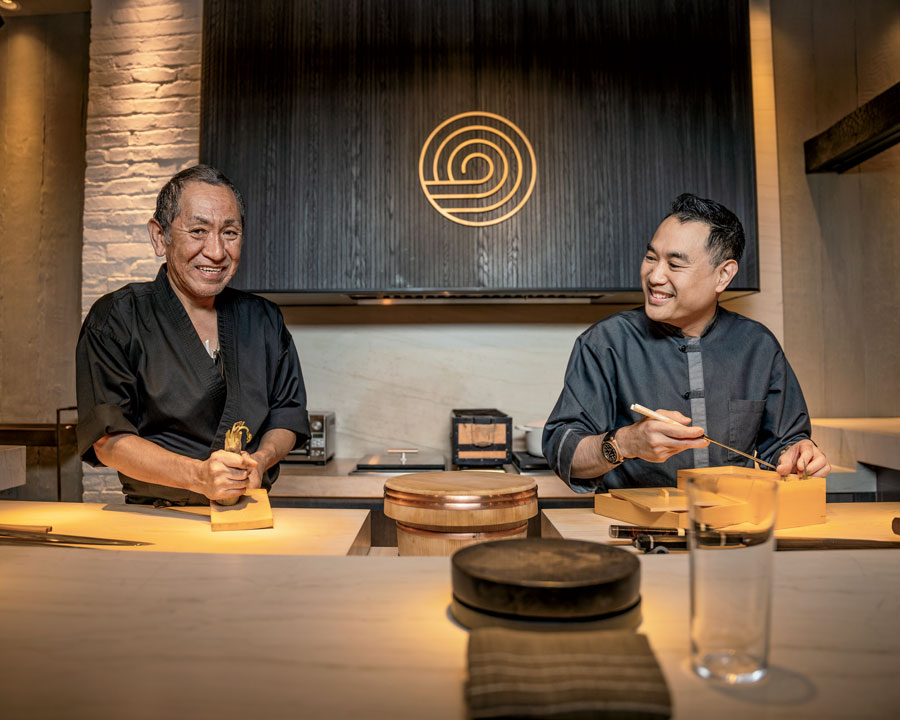
Patrick Bouaphanh (left) and Andrew Choi of Jinsei Motto
Some sushi spots, especially those that do omakase, can come across as sterile, as if the object of the meal is to worship at a very fishy altar rather than enjoy a great meal. At Jinsei Motto, owners Patrick Bouaphanh, 35, and Andrew Choi, 31, aim to do just the opposite. “We are young, and we think we know what people want,” explains Choi. “When I go out, I want to have fun, eat great food, and interact with the staff.” Their restaurant, located inside CH Distillery, has a chill vibe and a plant-bedecked bar, and if you want, you can get your sushi with a shot of Malört right from the source. Choi and Bouaphanh have been friends since 2015, when they worked at Sushi Dokku, and have traveled to Korea and Japan together. During the pandemic, they sold sushi platters out of ghost kitchens. Serendipity gave them the chance to start their own restaurant: The general manager of CH Distillery moved into the same apartment building as Bouaphanh, and they got to talking. In that era of COVID-driven experimentation, the idea of a high-end sushi restaurant taking up residence inside a distillery somehow made sense. Says Choi: “We want people to be relaxed, but still get the top tier.” — Anthony Todd

Otto Phan of Kyoten
“I was a very, very vain young man,” Otto Phan says laughingly of his early days in Chicago, when he’d just opened Kyoten. In 2018, he gave an interview to the Tribune calling out the city for its then-subpar sushi scene and boasting that he would have the first omakase restaurant in Chicago to merit a Michelin star. It was haughty talk for a man whose mother didn’t want him to even become a chef. “I was very much supposed to be a doctor but loved food too much,” says Phan, 38, who grew up in Houston. He trained in some top sushiyas, including New York’s Masa, before returning to Texas to open a food truck in Austin. He served rolls and bowls and became famous for his distinctively tangy rice, which pushed against the sweetness so prevalent in American sushi. From there it was an Austin omakase spot, and then Chicago. Michelin never came calling (and instead gave that particular honor to local rivals Omakase Yume and Mako), but Phan doesn’t care: “I don’t have to bend the knee to do well. I can do it on my own talent and push my craft to the utmost limits.” — John Kessler

Shigeru Kitano (left) and Kaze Chan of the Omakase Room at Sushi-San
The Omakase Room may be the newest addition to Chicago’s omakase lineup, but it employs two of the longest practicing sushi chefs in town: Shigeru Kitano, 59, and Kaze Chan, 50. Kitano, a chef since 1982, grew up in Japan and trained on the island of Hokkaido before moving to the United States in 1990. At the Omakase Room, he works alongside Chan, who has put in some years as well, starting out as a dishwasher in 1993 and rising through the ranks at places like Macku Sushi and Momotaro. Kitano’s heritage means he “will always have an anchor to Japanese tradition,” Chan says, and that keeps the Omakase Room grounded. Over Kitano’s decades in the industry — in Chicago, he worked at Hatsuhana, Kamachi , and Sushisamba — he’s seen, ahem, a sea change in American sushi. “When I started at Hatsuhana, the ingredients were, like, frozen hamachi, and the selection was very limited compared to what I knew in Hokkaido,” he says. Now he and Chan can get anything they want, straight from Japan, where fishermen and processors participate in competitions to sell fish abroad. The chefs taste a variety for a full month, unadorned, before creating new dishes, a process that draws on Kitano’s dedication to tradition. — Anthony Todd


